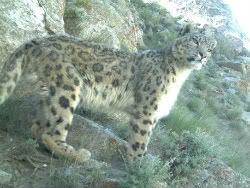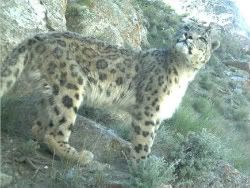(4 pm. – promoted by ek hornbeck)
Two amazing pictures of a rare snow leopard taken in a remote northeastern part of Afghanistan were released today by the Wildlife Conservation Society. These camera trap pictures were taken from the Sast Valley in Afghanistan’s Wakhan Corridor.
  |
Researchers are in the region conducting a wildlife survey with the goal of creating a protected area. The snow leopard is listed as endangered on the International Union for Conservation of Nature (IUCN) Red List.
Snow leopards have declined “over the past two generations (16 years) due to habitat and prey base loss, and poaching and persecution… Snow leopards are killed in retribution for livestock depredation, but also for commercial purposes, and poaching for illegal trade represents a significant threat… In Afghanistan, a new market has emerged which is difficult to police due to ongoing military conflict”.
That military conflict is proving to be deadly not only to Afghanistan’s snow leopard population, but also the country’s human population.
Afghan civilian deaths rose by 40 percent in 2008, the New York Times reported in February. The United Nations put the 2008 death toll at 2,118 civilians killed, much higher than in 2007 with 1,523 civilians killed in 2007, which previously was the deadliest year since the U.S.-led invasion began in November 2001.
For the first half of 2009, the Human Rights Unit of the United Nations Assistance Mission to Afghanistan (UNAMA) recorded 1,013 Afghan civilians killed (pdf) by the fighting. “As the conflict intensifies and spreads, it is taking an increasingly heavy toll on civilians,” UNAMA reported.
The rising civilian death toll is increasingly undermining support in Afghanistan for the NATO coalition operation, of which the United States is part. In June, the NY Times reported U.S. Gen. Stanley McChrystal issued a new policy that “sharply” restricted the use of airstrikes in Afghanistan “in an effort to reduce the civilian deaths that he said were undermining the American-led mission.”
Today, the Los Angeles Times reported McChrystal’s new policy may be working as the number of Afghan civilian deaths decline under new U.S. tactics.
Reporting from Kabul, Afghanistan – Western troops have killed far fewer Afghan civilians since the top U.S. general imposed strict new rules of engagement aimed at addressing one of the most contentious issues of the conflict, according to newly declassified U.S. military figures.
However, the data cover a relatively short period of eight weeks, and make it clear that civilians are still dying in large numbers, a pattern blamed in part on the Taliban’s campaign of violence surrounding last week’s national elections.
A possible example of the new tactic in place came earlier in the week. An Afghan Taliban commander was captured in a raid in eastern Afghanistan, the NY Times reported.
During the operation, which took place in the Sar Hawza district of Paktika Province, Afghan forces came under fire and called for assistance from American air and ground forces, said Lt. Cmdr. Christine Sidenstricker, a NATO spokeswoman. After the building was cleared of civilians, she said, an American Apache helicopter fired on the clinic, ending the battle.
“Once the troops were fired on from the clinic, it loses its protected status” as a civilian location where international forces may not fire, she said. “In addition, we made sure the building was cleared of civilians, and there were no civilian deaths.”
According to BBC News, there was at least one member of Afghanistan’s parliament who was angry over the attack on a medical clinic, but the outcry so far is much less when compared to the riot after the deadly U.S. airstrike in Farah in May or the protests after another deadly U.S. airstrike in the south earlier this month.
One U.S. soldier, however, was killed in the operation. The LA Times added that while military spokespeople deny any link between Western casualties and the new policy, the period in which the new airstrike policy has been in effect, has “also coincided with some of the heaviest losses of the war for Western forces.”
August is now the deadliest month for U.S. forces in Afghanistan, reports the AFP. The AFP reports August is deadliest month ever for the U.S. in Afghanistan. More American troops have been killed in Afghanistan in the month of August than any single month dating back to the U.S. invasion began in 2001. “At least 300 coalition soldiers have lost their lives since the beginning of the year, up from 294 in 2008,” according to icasualties.org.
The fate of Afghanistan’s snow leopards are tied to the way Americans and others end the fighting in the region. If the fighting lasts another eight years, another generation of snow leopards will be at risk from poachers either as a means of funding the insurgency or just a means of making ends meet. Wildlife conservation is difficult while people are busy killing each other.
Somehow the plight of an endangered cat loses its impact. But still at least for me, the two snow leopard pictures serve as a reminder that despite the horror of seemingly endless war in Afghanistan, the country has its moments of peace and tranquility.
Cross-posted from Daily Kos.

3 comments
Author
The ongoing war in Afghanistan, especially the influx of Westerners in the past 8 years, has created a market for the poachers with snow leopard pelts.
From redOrbit (June 2008), Endangered Afghan Snow Leopard Threatened By Poachers.
your diary to everyone I could think of. The pictures are amazing and they made my day. I don’t know if I commented there, but better late than never.